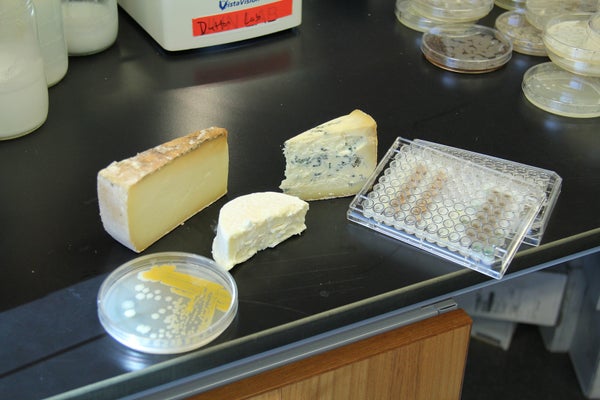This article was published in Scientific American’s former blog network and reflects the views of the author, not necessarily those of Scientific American
One of several reasons for my lack of blogging lately is that I'm on the job market. I'm applying for assistant professor positions at small liberal arts colleges, but it's going to be hard going - a lot of really talented and accomplished scientists will be applying for the same positions. One of the things I'm doing is building a companion website for my curriculum vitae that explains things in a bit more detail. As a result, I wrote up the work that I'm currently doing in the Dutton Lab, and thought it would make sense to share it here.
The Dutton Lab studies the microbes that grow on cheese, which is super fun to tell people about at parties. But the reason to study cheese goes far beyond an excuse to have delicious treats at lab meetings - we're studying communities of microbes. If you've been paying any attention, you've probably heard about the human "microbiome," the consortium of tiny critters that covers every body surface, packs our intestines, and seems to play important roles in everything from diabetes to depression. That's one microbial community that's clearly important, but complex multispecies microbial communities are everywhere (and everywhere important) from the soil under our crops, to the oceans producing our oxygen, to trash heaps and bioreactors. The trouble is, they're hard to study.
That's where the cheese comes in. The outer surfaces of aged cheeses (called the rind) are complex multispecies microbial communities. But crucially, this microbial community is much easier to study than those of an animal gut or soil. It's a model system - just like E. coli has been a model for molecular biology, or S. cerevisiae is a model to study cell biology, the microbial communities on cheese are tractable systems to study principals of microbial ecology.
On supporting science journalism
If you're enjoying this article, consider supporting our award-winning journalism by subscribing. By purchasing a subscription you are helping to ensure the future of impactful stories about the discoveries and ideas shaping our world today.
My project is looking for horizontal gene transfer (HGT) in our cheese microbes. Bacteria are asexual - when they reproduce, they split into two more-or-less identical copies. In principle, this cuts off mixing of genomes - all genes are "vertically" inherited, in other words, passed directly from parent to offspring. In practice though, a lot of mixing really does occur. Whether because of bacteria viruses (phages) accidentally packaging one victim's genes and pulling them along to another, or through conjugation (this is the closest thing to bacteria sex), or some other mechanism, bacteria are constantly sharing their genes with one another.
Precisely why or how or even how frequently this happens is not entirely clear, but I'm not really investigating any of these questions directly. I'm interested in HGT as a window into what's important in this microbial community. See, as tractable as the cheese microbial communities are, we're still missing a lot of traditional tools to study them. We might be able to convincingly show that there's an interaction between two species, but showing what the interaction is is a bit trickier. So I'm taking a genomic approach - using computational analysis to sift through all the genes of our bacteria to see if I can identify patterns that tell me something about what the bacteria think are important.
One way to do this would be to look for genes that are enriched in cheese genomes compared to non-cheese genomes of related species, but doing this with anything approaching statistical rigor would require a lot more genomes than we have access to. Evolution can take a long time, and small differences that have an impact may be tough to pull out from the noise. Instead, I'm looking at the HGT. The rationale here is that, while the core genomes of these microbes are going to look mostly like their close non-cheese relatives, there may be genes with super important functions that are being swapped around at a high frequency. It's much easier to find a gene that's brand new than it is to find something that's just a bit different.
So I'm writing a software package to scan through the genomes of our microbes and pull out genes that are likely to be horizontally transferred. What this means in practice is that I'm comparing each genome to a bunch of others, and if the software sees a gene that's super close between two species - much closer than you would expect based on their common ancestry - it gets flagged. To understand the rationale, consider humans and parakeets. We share a common ancestor with birds about 320 million years ago, but still share a huge number of genes that have been passed down from that ancestor. Of course, those genes have been accumulating mutations along the way, so though we can see that parakeet hemoglobin is related to human hemoglobin, they're pretty dissimilar at the level of A, C, G and T. If we found a gene that was 99% identical in humans and in a bird, we'd probably have to conclude that it was the result of horizontal gene transfer (though beyond intentional genetic manipulation, I don't think there's any known way for something like this to happen). That's what I'm looking for in our cheese microbes - genes that are 99% similar in species whose genes should be much more distantly related.
And I've found a bunch! A lot of them seem to be involved in acquiring nutrients, but you'll have to wait for more details until I actually write up a paper...
